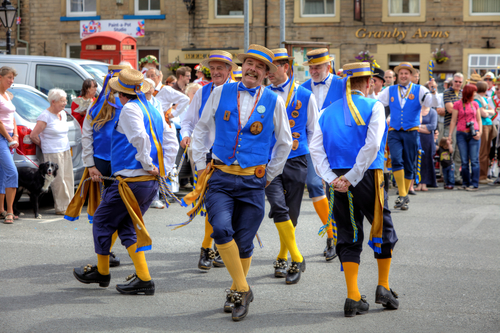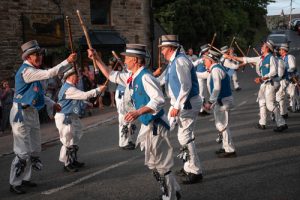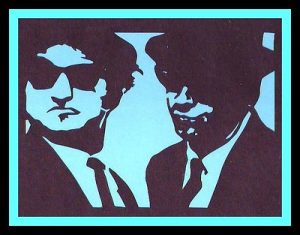
A Short History of Morris Dancing

Image credit: Steven4z/Shutterstock.com
Morris dancing is an ancient type of English folk dance that is usually performed to rudimentary music. It involves rhythmic, choreographed stepping by a group of practised dancers. The performers all wear similarly antiquated tunics, sometimes old-fashioned hats, with bells on specially designed shin pads. Sticks, swords, handkerchiefs and other items may be wielded by the dancers as part of their routine. Some dance teams also blacken up their faces for further theatrical effect.
Vague Origins
There is very little information that has been chronicled about the origins of Morris Dancing. Some believe that the dance evolved from Druidic springtime rituals. Others think that it has Moorish connections, brought to England from the crusades. A third possibility of the origins of Morris is that it derives from a 12th-century Italian court dance called the Moresca.
The earliest known written reference to Morris dancing in England is dated to 1448. Historical records confirm the payment of seven shillings to Morris dancers by the Goldsmiths’ Company in London. During the 16th century, there are accounts from several churches that list the purchase of Morris bells and costumes. It’s known that at the courts of both Henry VIII and Elizabeth I, the “ancient” tradition of the Morris dance was regularly performed. Shakespeare’s play, Henry V, also makes reference to Morris dancing.
Decline and Revival
In the 17th century, Cromwell and his puritanical regime denounced all forms of dancing along with many other festivities. This greatly contributed to the demise of Morris in many communities across the country. However, 1660 saw not only the restoration of the monarchy but also that of Morris dancing. The new king, Charles II landed at Dover on 25 May 1660 on his return from exile. On the 4-day journey to London it was reported that amongst the cheering masses, were thousands of Morris dancers. The revival of Morris saw dancing being performed by both men and women.
The main events in the calendar were tied to May Day and Whitsunday. Each village’s team of Morris dancers fashioned their own particular style. Thus, every procession, its characters, step routines, and musical accompaniment, became a little different.
Morris in the Modern Era
Morris dancing continued in popularity until the industrial revolution. However, the loss of patronage, changing attitudes, migration, and the growth of other leisure pursuits, contributed to its decline in the early 19th century. By the second half of the 19th century, many local fairs, regional pageants and other such like events had ceased. Thus, performance opportunities for Morris dancers went in to a severe decline. However, a small group of enthusiasts kept Morris alive during the late 19th and early 20th century. In the 1950s, and especially the 1960s, there was a particularly renewed interest in Morris dancing. This saw the formation of women’s and mixed sides, reviving the centuries-old tradition of female dancers.
Driven by expats, the Morris tradition has also spread to a good number of commonwealth countries. Particularly those with strong connections to the UK, such as Australia, Canada and New Zealand. Additionally, there are reckoned to be some 150 Morris dancing outfits in the USA. Isolated Morris groups are also known to exist in the Netherlands, Finland, Sweden, Cyprus and Hong Kong.
Header image credit: Debu55y/Shutterstock.com
If you’ve enjoyed reading this post, why not check out more of the articles in the series by clicking the following link: Why do we…….?






[…] Here’s a brief narrative on the old-age tradition of Morris dancing: […]